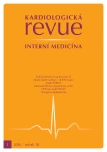To what values should we reduce systolic blood pressure? The SPRINT study
Authors:
M. Souček; I. Řiháček; J. Novák
Authors‘ workplace:
II. interní klinika LF MU a FN u sv. Anny v Brně Mezinárodní centrum klinického výzkumu FN u sv. Anny v Brně
Published in:
Kardiol Rev Int Med 2016, 18(1): 55-58
Category:
Cardiology Review
Overview
There is no clear consensus about the optimal target value of blood pressure lowering that would reduce cardiovascular events and cardiovascular and all-cause mortality. Within the ACCORD study, intensive systolic blood pressure (SBP) treatment with target values under 120 mm Hg was compared with standard treatment with target SBP values under 140 mm Hg, and a reduction below 120 mm Hg had no effect on the primary aim (i.e. all-cause mortality) in patients with diabetes mellitus. Now there is the SPRINT study, where results show a positive effect of intensive blood pressure lowering therapy on the combined primary aim that was defined as myocardial infarction, other acute coronary syndromes, stroke, heart failure or cardiovascular death; however, the results also show a statistically significant increase in the occurrence of side effects (hypotension, syncope, renal injury or failure).
Keywords:
systolic blood pressure – target values – cardiovascular events – hypotension
Sources
1. Franklin SS, Jacobs MJ, Wong ND et al. Predominance of isolated systolic hypertension among middle-aged and elderly US hypertensives: analysis based on National Health and Nutrition Examination Survey (NHANES) III. Hypertension 2001; 37: 869– 874.
2. Chobanian AV, Bakris GL, Black HR et al. The seventh report of the Joint National Committee on prevention, detection, evaluation, and treatment of high blood pressure: the JNC 7 Report. JAMA 2003; 289: 2560– 2572.
3. Hsu CY, McCulloch CE, Darbinian J et al. Elevated blood pressure and risk of end-stage renal disease in subjects without baseline kidney disease. Arch Intern Med 2005; 165: 923– 928.
4. Sundström J, Arima H, Jackson R et al. Effects of blood pressure reduction in mild hypertension: a systematic review and meta-analysis. Ann Intern Med 2015; 162: 184– 191. doi: 10.7326/ M14-0773.
5. Neal B, MacMahon S, Chapman N. Effects of ACE inhibitors, calcium antagonists, and other blood-- pressure-lowering drugs: results of prospectively designed overview of radomised trials. Lancet 2000; 356: 1955– 1964.
6. Psaty BM, Smith NL, Siscovick DS et al. Health outcomes associated with antihypertensive therapies used as first-line agents: systematic review and meta-analysis. JAMA 1997; 277: 739– 745.
7. Lewington S, Clarke R, Qizilbash N et al. Age-specific relevance of usual blood pressure to vascular mortality: a meta-analysis of individual data for one million adults in 61 prospective studies. Lancet 2002; 360: 1903– 1913.
8. Beckett NS, Peters R, Fletcher AE et al. Treatment of hypertension in pacients 80 years of age or older. N Engl J Med 2008; 358: 1887– 1898. doi: 10.1056/ NEJMoa0801369.
9. Verdecchia P, Staessen JA, Angeli F et al. Usual versus tight control of systolic blood pressure in non-diabetic patients with hypertension (Cardio.Sis): a open-label randomised trial. Lancet 2009; 374: 525– 533. doi: 10.1016/ S0140-6736(09)61340-4.
10. Cushman WC, Evans GW, Byington RP et al. ACCORD Study Group. Effect of intensive blood pressure control in type 2 diabetes mellitus. N Engl J Med 2010; 362: 1575– 1585. doi: 10.1056/ NEJMoa1001286.
11. Benavente OR, Coffey CS, Conwit R et al. SPS3 Study Group. Blood-pressure targets in pacients with recent lacunar stroke: the SPS3 randomised trial. Lancet 2013; 382: 507– 515. doi: 10.1016/ S0140-6736(13)60852-1.
12. Wright JT Jr, Williamson JD, Whelton PK et al. The SPRINT Group. A randomised trial of intensive versus standard blood-pressure control. N Engl J Med 2015; 373: 2103– 2116. doi: 10.1056/ NEJMoa1511939.
13. Perkovic V, Rodgers A. Redefining Blood-Pressure Targets – SPRINT starts the Marathon. N Engl J Med 2015; 373: 2175– 2178. doi: 10.1056/ NEJMe1513301.
14. Drazen JM, Morrissey S, Campion EW et al. A SPRINT to the Finish. N Engl J Med 2015; 373: 2174– 2175. doi: 10.1056/ NEJMe1513991.
15. Yeh JS, Barkis GL, Taler SJ. Clinical decision. Blood--pressure control. N Engl J Med 2010; 373: 2180– 2182. doi: 10.1056/ NEJMclde1513565.
16. Filipovský J, Widimský J, Ceral J et al. Diagnostické a léčebné postupy u arteriální hypertenze - verze 2012. Hypertenze a kardiovaskulární prevence 2013; 3: 1– 15.
17. Souček M, Widimský J, Lánská V. Control of hypertension in patients with hypertension, diabetes a impaired fasting glucose by Czech primary care physicians. Kidney Blood Press Res 2006; 29: 366– 372.
Labels
Paediatric cardiology Internal medicine Cardiac surgery CardiologyArticle was published in
Cardiology Review

2016 Issue 1
Most read in this issue
- Proton pump inhibitors – new molecules, new knowledge
- What to use in patients with ischaemic heart disease and atrial fibrillation – anticoagulation, antiaggregation or both?
- Hyperuricaemia, cardiovascular diseases and heart failure
- Cardiac cachexia
